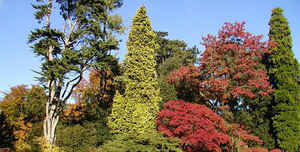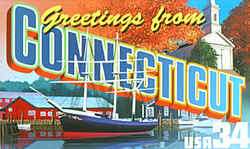
Connecticut Symbols
Connecticut State Tree
White Oak
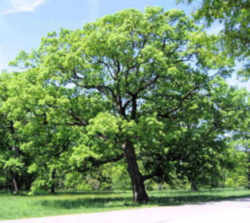
(Quercus alba)
Adopted on April 16, 1947.
Deep-rooted in the historic tradition of Connecticut, the Charter
Oak (White Oak) is one of the most colorful and significant symbols of the
spiritual strength and love of freedom which inspired our Colonial forebears
in their militant resistance to tyranny. The Charter Oak was a white oak tree
(Quercus albus) that fell during a great storm in 1856 at well over 200 years
of age. The Charter Oak {White Oak, (Quercus alba,)} was adopted as the
official Connecticut state tree in 1947.
Representative Edgerton introduced House Bill No. 688 promoting the white oak as the state tree of Connecticut. With the backing of the Connecticut
Tree Protective Association and the support of members of the State Forest Commission, the House approved this bill on March 11. Senate approval followed
on March 18.
On April 16, 1947, Governor James L. McConaughy signed the legislation making the white oak (Quercus alba) the state tree of Connecticut.
Connecticut State Tree: White Oak
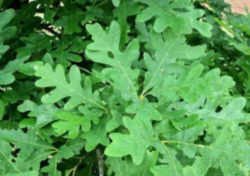
White oak, (Quercus alba,) is an outstanding tree among all trees and is widespread across eastern North America. The most important lumber tree of the white oak group, growth is good on all but the driest shallow soils. Its high-grade wood is useful for many things, an important one being staves for barrels, hence the name stave oak. The acorns are an important food for many kinds of wildlife.
Identification of the White Oak
- Leaf: Alternate, simple, oblong to ovate in shape, pinnately veined with an evenly lobed margin, 4 to 7 inches long. The apex is rounded and the base is wedge-shaped. Leaves are hairless, bright green above and whitish below.
- Flower: Male flowers are green, borne in naked catkins, 2 to 4 inches long. Female flowers are reddish and appear as single spikes. Appearing with the leaves.
- Fruit: Ovoid, but may be oblong, with a warty cap that covers 1/4 of the fruit. The cap always detaches at maturity. Matures in one year, ripens 120 days after pollination (July to September).
- Twig: Red-brown to somewhat gray, hairless, with red-brown multiple terminal buds that are small, rounded and hairless. Twigs are often shiny or somewhat glaucous.
- Bark: Whitish or ashy gray, varying from scaly to irregularly platy or blocky. On older trees smooth patches are not uncommon.
- Form: A large tree; when open grown, white oaks have rugged, irregular crowns that are wide spreading, with a stocky bole. In the forest crowns are upright and oval.
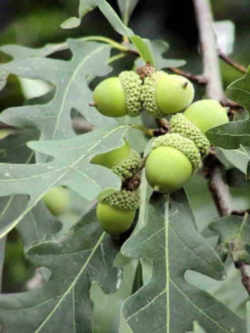
The following is a rendition of the story from the Connecticut Register & Manual and used with the permission of the Connecticut Secretary of State.
THE CHARTER OAK
(White Oak, Quercus alba)
STATE TREE
Deep-rooted in the historic tradition of Connecticut, the Charter Oak is one of the most colorful and significant symbols of the spiritual
strength and love of freedom, which inspired our Colonial forebears in their militant resistance to tyranny. This venerable giant of the forest, hundreds
of years old when it hid the treasured Charter in 1687, finally fell during a great storm on August 21, 1856.
Two English kings, a royal agent, a colonial hero and a candle-lit room are the figures and backdrop in one of the most thrilling chapters of America's
legend of liberty. The refusal of our early Connecticut leaders to give up the Charter, despite royal order and the threat of arms, marked one of the
greatest episodes of determined courage in our history.
On October 9, 1662, The General Court of Connecticut formally received the Charter won from King Charles II by the suave diplomacy of Governor John
Winthrop, Jr., who had crossed the ocean for the purpose. Twenty-five years later, with the succession of James II to the throne, Connecticut's troubles
began in earnest. Sir Edmund Andros, His Majesty's agent, followed up failure of various strategies by arriving in Hartford with an armed force to
seize the Charter. After hours of debate, with the Charter on the table between the opposing parties, the candle-lit room suddenly went dark. Moments
later when the candles were re-lighted, the Charter was gone. Captain Joseph Wadsworth is credited with having removed and secreted the Charter in
the majestic oak on the Wyllys estate.
Connecticut House Bill No. 688
House Bill No. 688 promoting the white oak as the state tree of Connecticut.
AN ACT DESIGNATING THE WHITE OAK AS THE STATE TREE.
Be it enacted by the Senate and House of Representatives in General Assembly convened:
Section 1. The white oak, quercus alba, shall be the state tree.
Sec. 2 The act shall take effect from its passage.
Connecticut Law
The law designating the white oak as the official Connecticut state tree is found in the General Statutes of Connecticut, Title 1, Chapter 3, Section 3-110.
TITLE 1 - PROVISIONS OF GENERAL APPLICATION.
CHAPTER 3 - PUBLIC RECORDS: GENERAL PROVISIONS.
SECTION 3-110.
Sec. 3-110. State tree. The white oak, Quercus alba, shall be the state tree.
(1949 Rev., S. 3584.)
Taxonomic Hierarchy: White Oak
Kingdom: Plantae - Plants
Subkingdom: Tracheobionta - Vascular plants
Superdivision: Spermatophyta - Seed plants
Division: Magnoliophyta - Flowering plants
Class: Magnoliopsida - Dicotyledons
Subclass: Hamamelididae
Order: Fagales
Family: Fagaceae - Beech family
Genus: Quercus L. - oak
Species: Quercus alba L. - white oak






